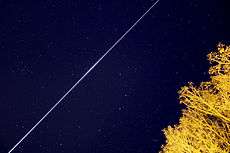Satellite watching

Satellite watching or satellite spotting is a hobby which consists of the observation and tracking of Earth artificial satellites.[1] People with this hobby are variously called satellite watchers, trackers, spotters, observers, etc.
Amateur satellite spotting traces back to the days of early artificial satellites when the Smithsonian Astrophysical Observatory launched the Operation Moonwatch (1956), a program to enlist amateur astronomers in the effort to track Soviet sputniks, in an analogy with the World War II Ground Observer Corps program to spot enemy bombers.[2] Moonwatch was crucial until professional stations were deployed in 1958. The program was discontinued in 1975.
There are many planetarium and satellite tracking computer programs to aid satellite spotting.[1] More recently, accompanied by the development of Augmented Reality technologies, satellite watching mobile programs have been developed.[3] During the 64th International Astronautical Congress 2013 in Beijing a citizen science method to track satellite beacon signals by a Distributed Ground Station Network (DGSN) was presented.[4][5] The purpose of this network is to support small satellites and cubesats of universities.
In February 2008 the front page of The New York Times hosted an article about an amateur satellite watcher Ted Molczan in relation to the story about falling American spy satellite USA 193. American officials were reluctant to provide information about the satellite, and instead, Ted Molczan, as the article says, "uncovers some of the deepest of the government’s expensive secrets and shares them on the Internet."[6]
NASA's Orbital Information Group have been providing free information about over 10,000 objects in Earth orbit. Recently this has been identified as a security threat, and a pilot program was launched in 2008 to replace the OIG website with a US Air Force site with more restrictive access.[7]
Spotting satellites
Satellite watching is generally done with the naked eye or with the aid of binoculars since most low Earth orbit satellites move too quickly to be tracked easily by telescope. It is this movement, as the satellite tracks across the night sky, that makes them relatively easy to see. As with any sky-watching pastime, the darker the sky the better, so hobbyists will meet with better success further away from light-polluted urban areas. Because geosynchronous satellites do not move relative to the viewer[8] they can be difficult to find and are not typically sought when satellite watching.[9]
Although to the observer low Earth orbit satellites move at about the same apparent speed as aircraft, individual satellites can be faster or slower; they do not all move at the same speed. Individual satellites never deviate in their velocity (speed and direction).[10] They can be distinguished from aircraft because satellites do not leave contrails. They are lit solely by the reflection of sunlight from solar panels or other surfaces. A satellite's brightness sometimes changes as it moves across the sky. Occasionally a satellite will 'flare' as its orientation changes relative to the viewer, suddenly increasing in reflectivity.[11] Satellites often grow dimmer and are more difficult to see toward the horizons.[1] Because reflected sunlight is necessary to see satellites, the best viewing times are for a few hours immediately after nightfall and a few hours before dawn. Given the number of satellites now in orbit, a fifteen-minute session of sky watching will generally yield at least one satellite passing overhead.
Satellite watcher clubs
There are many satellite watcher clubs, which collect observations and issue awards for observations according to various rules.[1]
- The Astronomical League has the Earth Orbiting Satellite Observers Club.[12]
See also
References
- 1 2 3 4 "Satellite Watching" at Hobbyspace.com
- ↑ "Smithsonian Astronomers Keep Hectic Pace", a 1957 article
- ↑ "Satellite Augmented Reality" iPhone Satellite Augmented Reality
- ↑ "Distributed Ground Station Network - A Gobal System For Tracking And Communication With Small Satellites As An Open Service", paper for IAC 2013 in Beijing on SlideShare
- ↑ "Distributed Ground Station Network @ International Astronautical Congress 2013", presentation during the IAC 2013 in Beijing (YouTube)
- ↑ Schwartz, John (February 5, 2008). "Satellite Spotters Glimpse Secrets, and Tell Them". The New York Times.
- ↑ "Satellite watchers worried about Air Force restrictions"
- ↑ "Geostationary orbit" at Wikipedia.com
- ↑ "Observing Geostationary Satellites" at Satobs.org
- ↑ "Three classes of orbit" at Nasa Earth Observatory
- ↑ "Satellite flare" at Wikipedia.com
- ↑ "Earth Orbiting Satellite Observers Club"
External links
- Real Time Satellite Tracking and Predictions
- Archive of SeeSat-L mailing list
- Satellite watching at DMOZ
- How to Spot Satellites at space.com
- Heavens Above computes times that satellites pass over your location.
